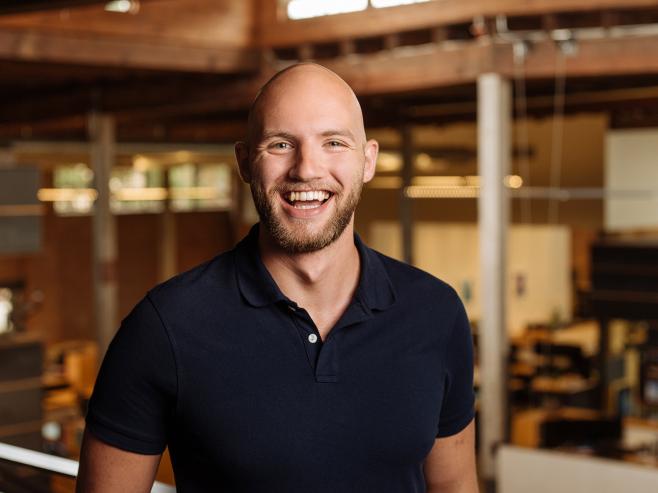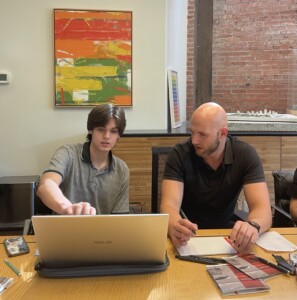
Overland Architect Jake Hyde Brings Energy to Design Practice, Firm Programs and Teaching UTSA Architecture Students
Resiliency Resounds in His Career and University Coursework
Everything architect Jakob Hyde, RA, WELL AP, does is humancentric. As a young designer, he strives to make architecture approachable, bringing together inspiring design with functionality. Such practice involves a high degree of empathy, not to mention creativity and deep dives into problem solving. But that is where Jakob, “Jake,” excels—researching, understanding, and ultimately creating a project that brings out the best in the people who live and work in the structures he designs.
From an early age, Jake knew he wanted to be an architect.
I’ve always been obsessed with space, how it feels, and how people interact with the built environment.
he said. While contemplating the world around him as he grew up, he took that inherent interest to technical school outside of Boston and studied architectural drafting, where he learned the principles of good construction drawing. By the time he reached college, he had a proficient software foundation for all that architecture school had in store.
While attending Wentworth Institute of Technology, where he was enrolled for five years across bachelor and master’s degree programs, he was immersed in the fast-paced energy of Boston. “I was thrust into an urban environment, and I quickly learned that it opened up a new window for me to study the ebb and flow of the city, the interaction of people with the built environment, and each other,” Jake said. The highlight of his university experience was the vibrant studio culture with open and collaborative dialogue that was part of each project. “I am a narrative thinker, so transforming robust words into graphics and diagrams is a natural process for me, and one that I was able to refine during my college experience,” he said. That same culture allowed him to test ideas in new ways and understand the collective impact of working as an individual, and as a member of a team.
Working in teams can offer a multitude of perspectives on design, which many times is the best way to create impactful architecture.
The collaborative atmosphere he enjoyed at the university, coupled with a strong sense of community, are what attracted him to Overland three years ago. Currently on the design team that works with large universities, Jake said he appreciates the approach Overland employs to unlock the embedded potential of people and places, known as The Human Handprint™. A human-centered design methodology pioneered by Overland, the firm uses the Human Handprint to guide clients through the design process and bring an intentional approach to connecting each client’s unique mission, vision and values to holistic sustainability and positive human impact. Personally, Jake strives to make architecture approachable, where beautiful design, sustainability and usability converge.
While working as a registered architect in a busy practice and coordinating the firm’s Lunch & Learn programs, what else could the 26-year-old put on his plate? A teaching gig. Jake is a new instructor at the University of Texas at San Antonio School of Architecture this semester, teaching Design 3 to second year architecture students. With a robust syllabus that includes some traditional assignments such as field sketching and modeling, the focus of Jake’s class is environmental resiliency.

The class has been tasked with designing a new community for residents living in San Antonio ten years from now, where increasingly extreme weather patterns yield unpredictable clean water and energy supplies. The studio posits that new structures will be needed to house these displaced populations, and will demand a holistic approach to both durable, long-lasting sustainability.
“We want today’s students to ponder a new model for how Texans should live in this new era of complex climate change, with ecological consciousness and resiliency in mind,” Jake said.
One of the most valuable lessons he tries to instill in his students is the understanding that the strongest and best ideas make use of careful, constant, and rigorous attention. “Not unlike editing a story, students are learning it takes many iterations to achieve something that provides value. And even then, it’s never finished,” said Jake.
While working with eighteen students over sixteen weeks, Jake not only hopes to expose pragmatic applications of architecture to the class, but also foster a closer connection to the design community at large. “I hope to use this opportunity to not only cultivate skill and design development, but to try and bridge the gap between the academy and practice,” he said. “Those two worlds can sometimes be disparate things. In doing what we do – as architects – you need a constant and continuous connection to both. I feel teaching can make you a better architect, and practicing makes you a better teacher – ‘iron-sharpens-iron’ that way.”
With his affable personality, creativity, practical design knowledge, and a deep appreciation for what collaboration can do, Jake hopes to shepherd a new generation of architects – or, as he puts it “at least these eighteen” to inspire thinking about collaborative problem-solving and the power of design to elevate communities. Optimistic about his students and the semester, Jake is looking for opportunities to bring Overland staff into each of his project reviews. “We have a really talented, creative community here at Overland whose feedback is pretty invaluable to me on a daily basis,” he says. “I’d be a fool not to employ that in a crit room, too.”
Creating places that can’t be built by anyone else
…for anyone else.
